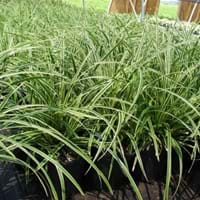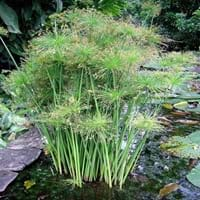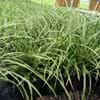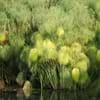Life Span
Perennial
Perennial
Type
Sedge or Rush
Sedge or Rush
Origin
Japan
World/Pandemic
Types
Not Available
Not available
Habitat
Lawn, shaded fields, Shaded sites
Grassland, Wet lands
USDA Hardiness Zone
5-9
7-11
Sunset Zone
3a, 3b, 4, 5, 6, 7, 8, 9, 14, 15, 16, 17, 18, 19, 20, 21, 22, 23, 24
H1, H2, 16, 17, 23, 24
Habit
Clump-Forming
Spreading
Minimum Height
Not Available
Minimum Width
Not Available
Flower Color
Tan
Green, Brown
Flower Color Modifier
Bicolor
Not Available
Fruit Color
Non Fruiting Plant
Not Available
Leaf Color in Spring
Green, Light Yellow
Green
Leaf Color in Summer
Green, Light Yellow
Green
Leaf Color in Fall
Green, Light Yellow
Green
Leaf Color in Winter
Tan
Not Available
Leaf Shape
Long Narrow
Grass like
Plant Season
Spring, Summer, Fall, Winter
Spring, Summer, Fall
Sunlight
Partial shade, Full Shade
Full Sun, Partial Sun, Partial shade
Growth Rate
Medium
Medium
Type of Soil
Clay, Loam
Clay, Loam, Sand
The pH of Soil
Acidic, Neutral
Acidic, Neutral, Alkaline
Soil Drainage
Well drained
Poorly Drained
Bloom Time
Early Summer, Summer
Early Summer, Summer, Late Summer, Early Fall
Tolerances
Drought
Drought
Where to Plant?
Container, Ground, Pot
Container, Ground, Pot
How to Plant?
Divison, Seedlings
Bulbs, Divison, Rhizome division, Tubers
Plant Maintenance
Medium
Medium
Watering Requirements
Average Water Needs
Do not let dry out between waterings, Keep ground moist, Keep the Soil well drained
In Summer
Lots of watering
Lots of watering
In Spring
Moderate
Moderate
In Winter
Average Water
Average Water
Soil pH
Acidic, Neutral
Acidic, Neutral, Alkaline
Soil Type
Clay, Loam
Clay, Loam, Sand
Soil Drainage Capacity
Well drained
Poorly Drained
Sun Exposure
Partial shade, Full Shade
Full Sun, Partial Sun, Partial shade
Pruning
Remove damaged leaves, Remove dead branches, Remove dead leaves
No pruning needed
Fertilizers
All-Purpose Liquid Fertilizer
can go long without fertilizers
Pests and Diseases
Red blotch
Red blotch
Plant Tolerance
Drought
Drought
Flowers
Insignificant
Showy
Flower Petal Number
Single
Single
Foliage Texture
Fine
Fine
Foliage Sheen
Glossy
Glossy
Attracts
Bees
Birds, Butterflies, Flying insects
Allergy
Itchiness
Itchiness, Skin rash
Aesthetic Uses
Showy Purposes
Beautification, Bog Garden, Showy Purposes, Used for decorating walls, fences, gates, hedges, etc.
Beauty Benefits
Not Available
Not Available
Environmental Uses
Air purification
Air purification
Medicinal Uses
Not Available
No Medicinal Use
Part of Plant Used
Not Available
Not Available
Other Uses
Not Available
Container, Decoration Purposes, Florist trade and landscaping, Used as Ornamental plant
Used As Indoor Plant
No
Yes
Used As Outdoor Plant
Yes
Yes
Garden Design
Container, Edging, Groundcover, Mixed Border, Rock Garden / Wall
Bog Garden, Container, Tropical, Water Gardens
Botanical Name
Carex Morrowii
Cyperus papyrus
Common Name
Japanese Sedge, Carex Grass Evergold
Dwarf papyrus, Miniature papyrus
In Hindi
Carex Grass Evergold
dwarf papyrus
In German
Carex Grass Evergold
Zwerg Papyrus
In French
Carex Grass Evergold
papyrus nain
In Spanish
Carex Grass Evergold
papiro enano
In Greek
Carex Grass Evergold
νάνος πάπυρο
In Portuguese
Carex Grass Evergold
papiro anão
In Polish
Carex Grass Evergold
krasnolud papirus
In Latin
Carex Grass Evergold
P. papyrus
Phylum
Tracheophyta
Tracheophyta
Class
Magnoliopsida
Magnoliopsida
Family
Cyperaceae
Cyperaceae
Clade
Angiosperms, Commelinids, Monocots
Angiosperms, Commelinids, Monocots
Tribe
Not Available
Not Available
Subfamily
Not Available
Not Available
Season and Care of Carex Grass Evergold and Dwarf Papyrus
Season and care of Carex Grass Evergold and Dwarf Papyrus is important to know. While considering everything about Carex Grass Evergold and Dwarf Papyrus Care, growing season is an essential factor. Carex Grass Evergold season is Spring, Summer, Fall and Winter and Dwarf Papyrus season is Spring, Summer, Fall and Winter. The type of soil for Carex Grass Evergold is Clay, Loam and for Dwarf Papyrus is Clay, Loam, Sand while the PH of soil for Carex Grass Evergold is Acidic, Neutral and for Dwarf Papyrus is Acidic, Neutral, Alkaline.
Carex Grass Evergold and Dwarf Papyrus Physical Information
Carex Grass Evergold and Dwarf Papyrus physical information is very important for comparison. Carex Grass Evergold height is Not Available and width Not Available whereas Dwarf Papyrus height is 20.30 cm and width 25.40 cm. The color specification of Carex Grass Evergold and Dwarf Papyrus are as follows:
Carex Grass Evergold flower color: Tan
Carex Grass Evergold leaf color: Green and Light Yellow
Dwarf Papyrus flower color: Green and Brown
- Dwarf Papyrus leaf color: Green
Care of Carex Grass Evergold and Dwarf Papyrus
Care of Carex Grass Evergold and Dwarf Papyrus include pruning, fertilizers, watering etc. Carex Grass Evergold pruning is done Remove damaged leaves, Remove dead branches and Remove dead leaves and Dwarf Papyrus pruning is done No pruning needed. In summer Carex Grass Evergold needs Lots of watering and in winter, it needs Average Water. Whereas, in summer Dwarf Papyrus needs Lots of watering and in winter, it needs Average Water.





